The following is a scanned image of pages comprising a letter and a report provided to my by a friend and fellow officer who was, at that time, serving at the Infantry Centre. For the convenience of the reader (and for the benefit of search engines) a typed version is also provided:
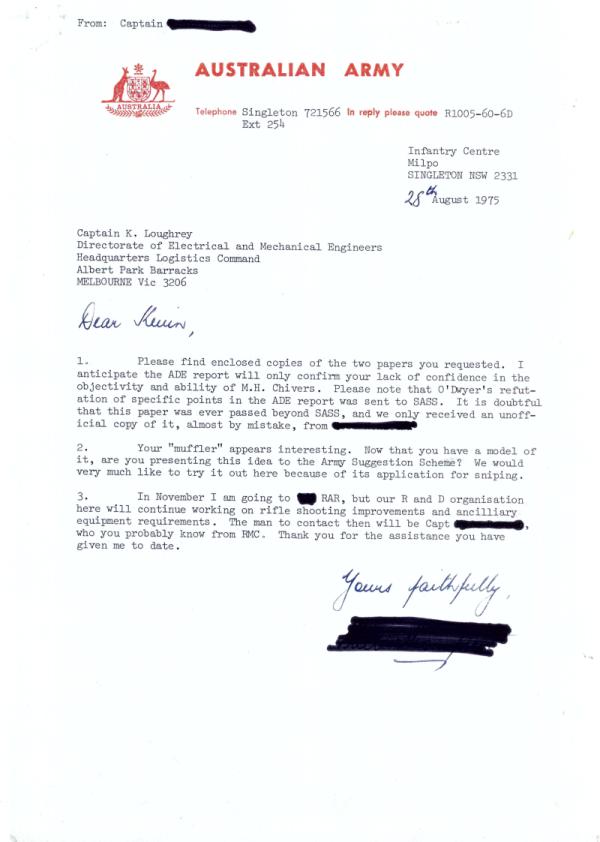
From: Captain (blacked out)
AUSTRALIAN ARMY Telphone Singleton 721566 in reply please quote R1005-60-6D Ext 254
Infantry Centre
Milpo SINGLETON NSW 2331 28 August 1975
Captain K. Loughrey Directorate of Electrical and Mechanical Engineers Headquarters Logistics Command Albert Park Barracks MELBOURNE Vic 3206 Dear Kevin, 1. Please find enclosed copies of the two papers you requested. I anticipate the ADE report will only confirm your lack of confidence in the objectivity and ability of M.H. Chivers. Please note that O'Dwyer's refutation of specific points in the ADE report was sent to SASS. It is doubtful that this paper was ever passed beyond SASS, and we only received an unofficial copy of it, almost by mistake from xxxx xxxxxxxx. 2. Your "muffler" appears interesting. Now that you have a model of it, are you presenting this idea to the Army Suggestion Scheme? We would very much like to try it out here because of its application for sniping. 3. In November I am going to X RAR, but our R and D organisation here will continue working on rifle shooting improvements and ancilliary equipment requirements. The man to contact then will be Capt xxxxxxxx who you probably know from RMC. Thank you for the assistance you have given me to date.
Yours faithfully,
(Signature blacked out to maintain anonimity of author) |
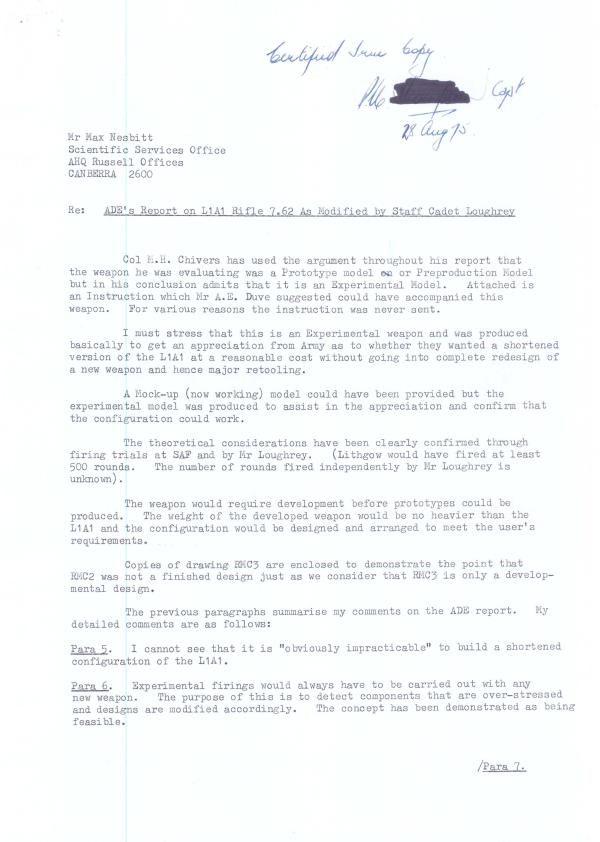
Mr Max Nesbitt Scientific Services Office AHQ Russell Offices CANBERRA 2600 Mr Re:AADE's Report on L1A1 Rifle 7.62 as Modified by Staff Cadet Loughrey
Col M.H. Chivers has used the argument throughout his report that the weapon he was evaluating was a Prototype model or Preproduction Model but in his conclusion admits that it is an Experimental Model. Attached is an instruction which Mr A.E. Duve suggested could have accompanied the weapon. For various reasons the instruction was never sent.
I must stress that this is an Experimental weapon and was produced basically to get an appreciation from Army as to whether they wanted a shortened version of the L1A1 at a reasonable cost without going into complete redesign of a new weapon and hence major retooling. A Mock-up (now working) model could have been provided but the experimental model was produced to assist in the appreciation and confirm that the configuration could work. The theoretical consideration have been clearly confirmed through firing trials at SAF and by Mr Loughrey. (Lithgow would have fired at least 500 rounds. The number fired independently by Mr Loughrey is unknown.) The weapon would require development before prototypes could be produced. The weight of the developed weapon would be no heavier than the L1A1 and the configuration would be designed and arranged to meet the user's requirements. Copies of drawing RMC3 are enclosed to demonstrate the point that RMC2 was not a finished design just as we consider that RMC3 is only a developmental design. The previous paragraphs summarise my comments on the ADE report. My detailed comments are as follows: Para 5. I cannot see that it is "obviously impracticable" to build a shortened configuration of the L1A1. Para 6. Experimental firings would always have to be carried out with any new weapon. The purpose of this is to detect components that are over-stressed and designs are modified accordingly. The concept has been demonstrated as being feasible. ../Para 7.
|
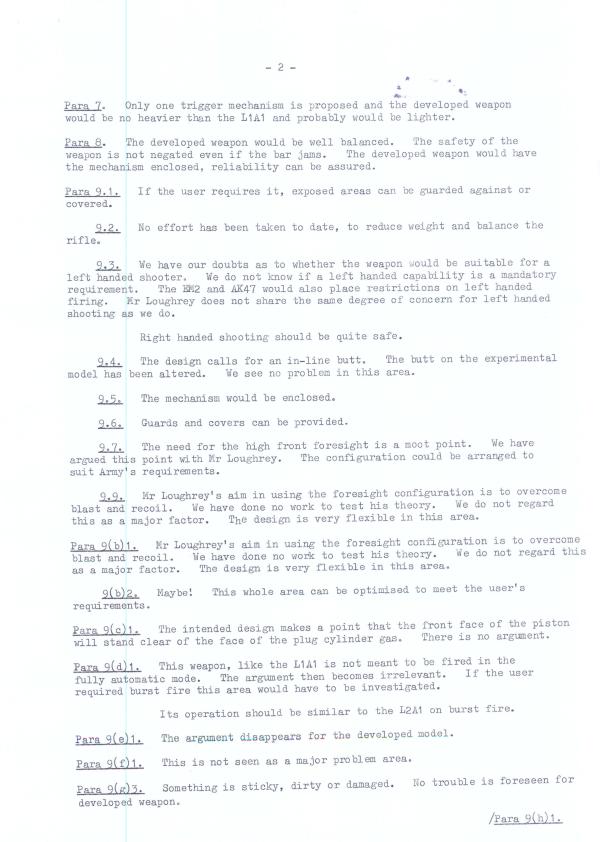
Para 7. Only one trigger mechanism is proposed and the developed weapon would be no heavier that the L1A1 and probably would be lighter. Para 8. The developed weapon would be well balanced. The safety of the weapon is not gegated even if the bar jams. The developed weapon would have the mechanism enclosed, reliability can be assured. Para 9.1. If the user requires it, exposed areas can be guarded against or covered.
Para 9.3. We have our doubts as to whether the weapon woudl be suitable for a left handed shooter. We do not know if a left handed capability is a mandatory requirement. The EM2 and AK47 would also place restrictions on left handed firing. Mr Loughrey does not share the same degree of concern for left handed shooting as we do. Right handed shooting should be quite safe. Para 9.4. The design calls for an in-line butt. The butt on the experimental model has been altered. We see no problem in this area. Para 9.5. The mechanism will be enclosed. Para 9.6. Guards and covers can be provided. Para 9.7. The need for the high front foresight is a moot point. We have argued this point with Mr Loughrey. Thje configuration could be arranged to suit Army's requirements. Para 9.9. Mr Loughrey's aim in using the foresight configuration is to overcome blast and recoil. We have done no work to test his theory. We do not regard this as a major factor. The design is very flexible in this area. 9(b)2. Maybe! This whole area can be optimised to meet the user's requirements. Para 9(c)1. The intended design makes a point that the front face of the piston will stand clear of the face of the plug cylinder gas. There is no argument. Para 9(d)1. This weapon, like the L1A1 is not meant to be fired in the fully automatic mode. The argument then becomes irrelevant. If the user required burst fire this area would have to be investigated. Its operation should be similar to the L2A1 on burst fire. Para 9(e)1. The argument disappears for the developed model. Para 9(f)1. This is not seen as a major problem area. Para 9(g)3. Something is sticky, dirty or damaged. No trouble is foreseen for developed weapon. /Para 9(h)1.
|
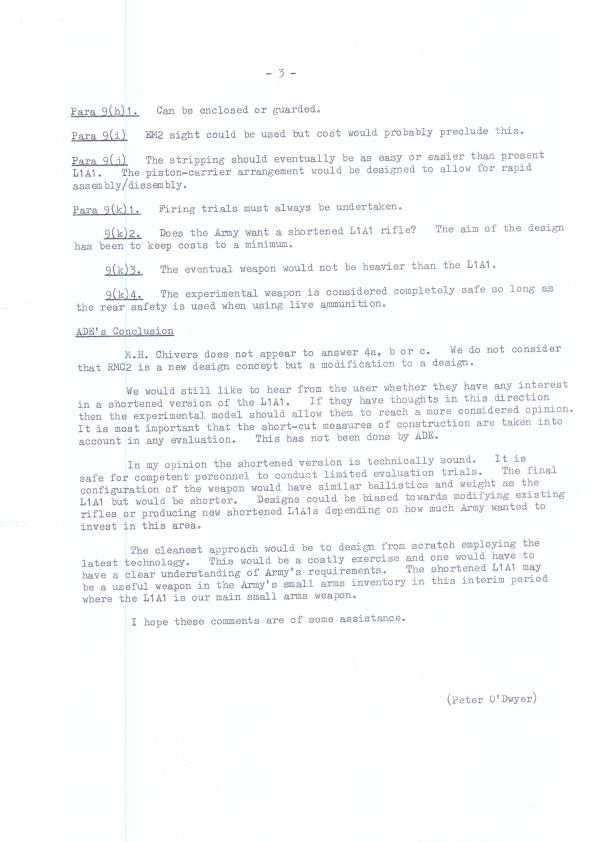
Para 9(h)1. Can be enclosed or guarded. Para 9(i) EM2 sight could be used but cost would most probably preclude this. Para 9(j) The stripping should eventually be as easy or easier than present L1A1. The piston-carrier arrangement would be designed to allow for rapid assembly/dissembly Para 9(k)1. Firing trials must always be undertaken.
9(k)3. The eventual weapon will not be heavier than the L1A1. Right handed shooting should be quite safe. 9(k).4. The experimental weapon is considered completely safe so long as the rear safety is used when using live ammunition. M.H. Chivers does not appear to answer 4a, b or c. We do not consider that RMC2 is a new design concept but a modification to a design. We would still like to hear from the user whether they have any interest in a shortened version of the L1A1. If they have thoughts in this direction then the experimental model should allow them to reach a more considered opinion. It is most important that the short-cut measures of construction are taken into account in any evaluation. This has not been done by ADE. In my opinion the shortened version is technically sound. It is safe for competent personnel to conduct limited evaluation trials. The final configuration of the weapon would have similar ballistics and weight as the L1A1 but would be shorter. Designs could be biased towards modifying existing rifles or producing new shortened L1A1s depending on how much Army wanted to invest in this area. The cleanest approach would be to design from scratch employing the latest technology. This would be a costly exercise and one would have to have a clear understanding of Army's requirements. The shortened L1A1 may be a useful weapon in the Army's small arms inventory in this interim period where the L1A1 is our main small arms weapon. I hope these comments are of some assistance. (Peter O'Dwyer)
|
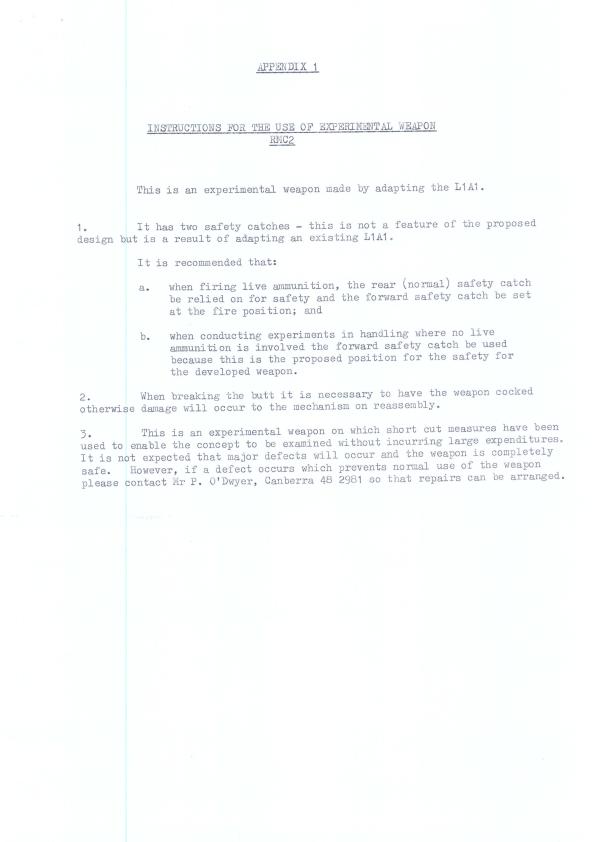
INSTRUCTIONS FOR THE USE OF THE EXPERIMENTAL WEAPON RMC2
This is an experimental weapon made by adapting the L1A1.
1. It has two safety catches - this is not a feature of the proposed design but is a result of adapting an existing L1A1. It is recommended that:
2. When breaking the butt it is necessary to have the weapon cocked otherwise damage will occur to the mechanism on reassembly. 3. This is an experimental weapon on which short cut measures have been used to enable the concept to be examined without incurring large expenditures. It is not expected that major defects will occur and the weapon is completely safe. However, if a defect occurs which prevents normal use of the weapon please contact Mr P. O'Dwyer, Canberra 48 2981 so that repairs can be arranged. |